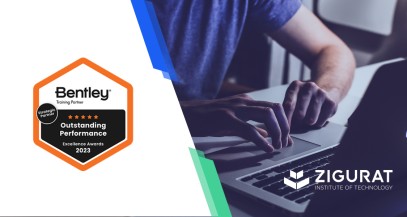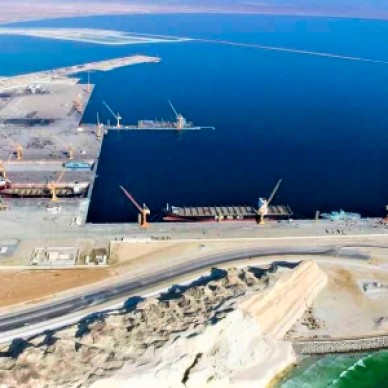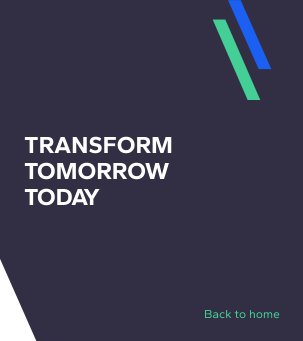
Zigurat alumnus Miguel Ouro creates a Machine Learning tool that can automate workflows in different stages of BIM
Categories

Miguel Ouro Mosquera is a civil engineer with appetite for innovation and passion for learning new tech tricks. As an institution, Zigurat Global Institute of Technology has always celebrated the students who forge their own unique path and help the others see the endless possibilities that the rise of new technologies means for their sector.
Miguel is one of those restless professionals who is always on the lookout of the new and the unknown. Having recently graduated from Master’s in Global BIM Management for Infrastructure Projects, in no time, he dived into business analytics and big data, all that while working full time at Indra, one of the leading global technology and consulting companies.
Miguel’s final project of the master’s explored how by automating processes with a Machine Learning (ML) application can save time and improve efficiency within BIM 4D & 5D. The main idea was to create a tool that can automate some workflows within the different stages of BIM.
Finding his own path
Miguel Ouro Mosquera started out as MSc Civil Engineer and in his beginnings got to know well the stages of design, construction of civil engineering works. Over time, as he gained more experience and acquired new responsibilities, he started to perceive that many construction processes of a project could be improved. That’s how his interest in technology and, more specifically, how to apply it to engineering and construction projects, developed.
“In my work, I have always sought to position myself in more technological projects and that has led me to what I dedicate myself to today,” Miguel explains when asked about his job at Indra, where he dedicates to find solutions for the transportation and maritime sector that will permit to take better advantage of the resources available. Achieving that through the design of products and technological solutions from the strategic conception to the deployment and implementation.
The potential of BIM when integrated with other technologies
As someone who doesn’t work with BIM daily, Miguel Ouro’s motives to study a master’s program dedicated to the underlyings of this methodology were somewhat different from other participants. For him, BIM represents a methodology that can be considered as a great source of information and data: “To be able to exploit it through business analytics and artificial intelligence seemed to me of tremendous interest to my current and future career.” Miguel considers BIM one of the technologies that is transforming the construction sector, both architecture and civil, and didn’t want to miss the opportunity to acquire knowledge in that field.
Continuous learning as the key to staying up-to-date
In times of rapid technological advancements and constant changes, it’s an imperative for Miguel to always keep training and be motivated to learn in order to stay as updated as possible in terms of knowledge, new technologies and trends. Balancing work life with studying takes determination, but he feels lucky since, in the companies he has worked for, continuous improvement and learning have been a maxim.
Getting out of one’s comfort zone is when the learning begins. “That was what happened to me during my master's studies, where it is necessary to face and know many tools of great value, and in which without becoming an expert, it is necessary to acquire knowledge to face real jobs,“ he considers the Global BIM Management for Infrastructure Projects program an enriching experience, especially with respect to the content and professors. Miguel feels that community and ecosystem of knowledge were created that resulted in very conducive to the individual development of each student.
Machine Learning for streamlining BIM workflows
Nowadays, projects generate a lot of data, even more so where BIM is applied. In Miguel’s experience, one of the big problems that project managers or planning managers always face is defining activity durations and costs within a project with high accuracy. Normally, this is done based on experience and through a good breakdown of activities, allocation of resources of people, machinery, materials, and time.
Inspired by that, his final project revolved around the concept of how through structured databases obtained in different projects and applying different machine learning algorithms one or several models can be created that provide durations to different work activities, reducing interaction and human error, considering multiple variables and data from projects prior to the same time. Similarly, once the durations for given resources have been defined, the cost can be optimized through the combination of the different variables considered.
Digital transformation in infrastructure engineering
In the infrastructure engineering, recent times have brought many changes, and, in the near future, the maturity of the sector will have to grow exponentially in terms of digital transformation if it wants to adapt to the market demand. When asked about the new technologies that will have the biggest impact on the sector, Miguel identified three main lines of work.
First is to improve collaborative work across the ecosystem, and BIM will undoubtedly have a relevant role, so work in real time will be the natural trend. Second, the automation and standardization of processes: we must be able to automate repetitive procedures towards modular and prefabrication construction, both in creating modular construction processes and using Robotic Process Automation (RPA) for document management or streamlining information flows. And, finally, Miguel is positive that the use of artificial intelligence will become massive in short time. There are great amounts of information that up until now have not been put into good use, but that with the AI input would improve performance, workflows, designs and execution methods.
Technology as a countermeasure to the uncertain times
As Miguel sees it, the construction sector has not yet exploited new technologies en masse and everything that these could offer. Perhaps because it is a sector where the degree of technological maturity is still behind others such as retail or banking. However, the crisis, that there’s been much talk about, will surely accelerate the process of change and digitalization and he is hopeful that “perhaps this ‘mandatory’ push will allow the various stakeholders to make a definite commitment to adopting their business culture for digital solutions”.
Today, there are many companies that are already launching different initiatives and internal pilots where new digital solutions are adopted, and they are obtaining really satisfactory results. For Miguel, the challenge now lies in transferring all this innovation and solutions to the entire company and to all the existing workflows. What will it take to get there? “Time, a good digital strategy performance plan, and lots of support from the CEOs to each worker of the company. It is necessary to believe that it can be done and put the necessary resources and patience to carry it out successfully,” advises Miguel as the Digital Transformation, Business Analytics & Strategy Consultant he is.
There’s always room for improvement and more innovation
Speaking about what the future holds for him, during the next months, Miguel Ouro will continue working on several projects that include designing solutions based on different technologies such as IoT, Blockchain and Artificial Intelligence and Business Analytics. He is hopeful that he will also have a chance to work more with BIM and use it to generate added value to the ecosystem of the logistics and maritime-port sector though a more horizontal collaboration between different stakeholders and the execution of different monetization strategies for data to be able to exploit them.


